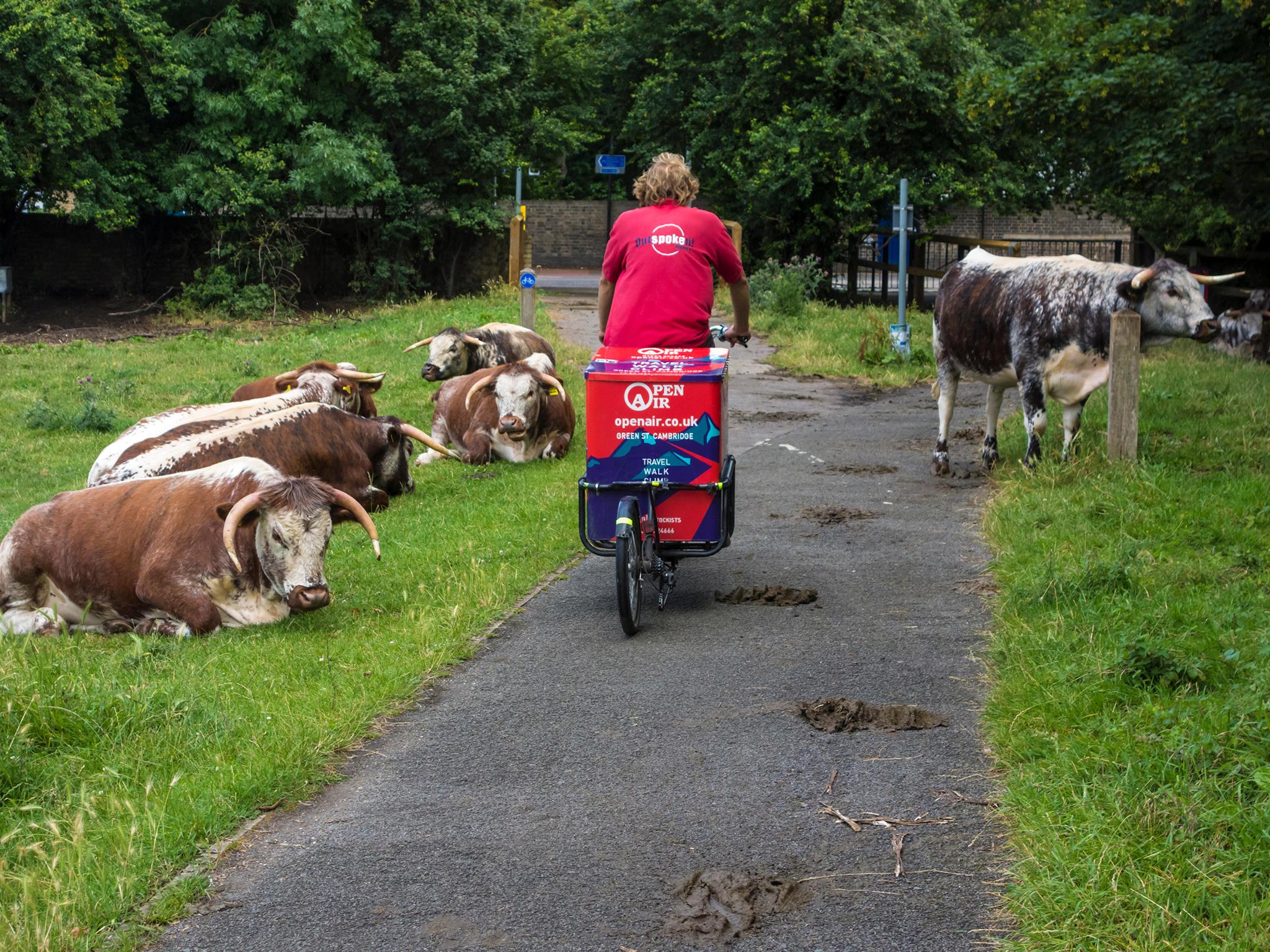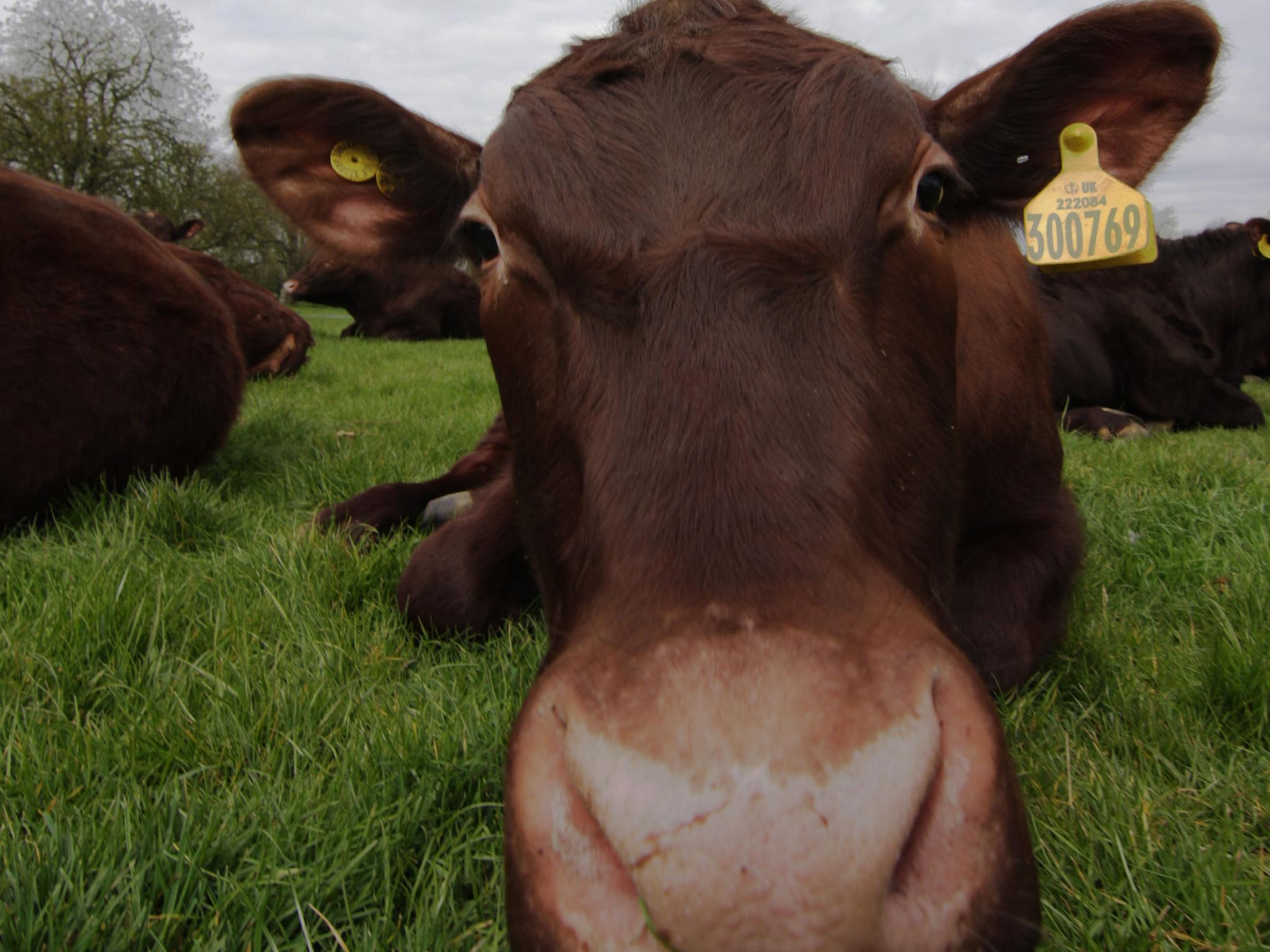Why cows still roam the commons of Cambridge
Cambridge's iconic urban cattle are a hangover from when locals used public spaces to graze livestock. Nowadays, though well-loved by many residents, the inner city herds draw some criticism

Your support helps us to tell the story
From reproductive rights to climate change to Big Tech, The Independent is on the ground when the story is developing. Whether it's investigating the financials of Elon Musk's pro-Trump PAC or producing our latest documentary, 'The A Word', which shines a light on the American women fighting for reproductive rights, we know how important it is to parse out the facts from the messaging.
At such a critical moment in US history, we need reporters on the ground. Your donation allows us to keep sending journalists to speak to both sides of the story.
The Independent is trusted by Americans across the entire political spectrum. And unlike many other quality news outlets, we choose not to lock Americans out of our reporting and analysis with paywalls. We believe quality journalism should be available to everyone, paid for by those who can afford it.
Your support makes all the difference.Some residents of Cambridge are so fond of their local cattle that only Latin can do justice to their feelings.
“It gives a sense of rus in urbe, which means rusticity in town,” muses Alex Perkins, a Cambridge University librarian, as a dark red steer meanders across his evening commute.
About 120 cattle roam amid the city parks and gothic towers of this medieval university town and, stepping over the cow pies, the human residents profess an improbable pride in their bovine neighbours.
“Seeing a cow gives a kind of rural feeling, the momentary illusion of being out in the country,” adds Perkins, who works in the university’s Jesus College. “Parks do that to a certain extent, too, of course. But cows do it better.”
The earliest settlers in what is now Cambridge built on a kind of gravelly island in a marshland about 50 miles northeast of London. In areas too low and soggy for construction or farming, they set aside fields for shared use by locals to graze livestock. Cattle grazed similar commons in towns across England, including in London.
But such commons began to come under siege about 400 years ago, as the gentry pushed to enclose more land into private properties. In the area around Cambridge, wealthy landowners hired a Dutch engineer to drain the marshland for arable farmland, arousing violent resistance from locals who had depended on the wetlands for fishing, fowling and hunting.
In London and other towns, urbanisation and industrialisation eventually squeezed out the cattle.
In Cambridge, the business of scholarship applied no such pressures and the cows held their ground. The urban herds became yet another emblem of the city’s distinction, like the white-robed boys’ choirs singing in the college chapels or the flat-bottomed boats of boozy picnickers crowding the river.
Oxford has nice gardens and meadows, too, Cantabrigians often note. But only Cambridge has so many cattle wandering in the middle of downtown.

“The cows provide a connection through the centuries to the ancient uses of this land, which is as pasture,” Jon Sanders, a recent graduate working in university administration, reflects as he walks home through the city’s Midsummer Common.
“The countryside penetrates right into the middle of the city,” he says, and most residents are happy to overlook the inconvenience of asphalt paths that become “slippery and excremental”.
The fellows of King’s College voted in 1772 to let sheep munch down the grassy yard by the chapel, to maintain its “good and ornamental condition”, according to an official history on its website.
Shopping in the city centre, you are a quarter of a mile away from grazing cattle. It is the uniqueness of Cambridge
But sheep lack the gravitas of cattle, and “today, the cows carry out a similar function in a rather more decorous manner”, the same history concludes.
As the human population has grown to 130,000 with an influx of drug and technology companies as well as affluent commuters, the cattle have taken on “this iconic status now”, said Susan Oosthuizen, a Cambridge historian who has studied the commons. “Because seeing cows is certainly not what we expect in a 21st-century urban environment.”
Some environmentalists complain that common use rights are a scourge on the British countryside.
While Americans usually draw bright lines between their public and private spaces, the tradition of common use rights that keeps cows in Cambridge also allows British farmers to graze their herds – typically sheep – across vast rural parklands that might otherwise be forests or wild.
“Our national parks, which are supposed to be the equivalent to American national parks, are ranches,” says George Monbiot, a writer leading a crusade against the grazing of British hillsides by what he calls “Mesopotamian ruminants”. (The ancestors of modern sheep were Middle Eastern migrants.)
“The cow is at least descendant from an animal that was once native here,” Monbiot concedes. “But having cows instead of sheep does not mean you are anywhere closer to nature.”
Still, Anthony French, who manages the city parks, insists that overall the cattle and Cantabrigians live in a happy symbiosis.

The cattle save the cost of lawnmowing. They munch the grass to varying heights – a pattern known to horticulturalists as a diversity of sward – which fosters biodiversity.
And the beetles that feast on the cow dung are a treat of birds, bats and other animals.
“Shopping in the city centre, you are a quarter of a mile away from grazing cattle,” French marvels. “It is the uniqueness of Cambridge.”
When livestock roamed other cities, governments employed an officer to apprehend animals that wandered off or created a nuisance. The officer, who was known as the pinder, pinned or penned the strays in a central location until their owners paid to reclaim them.
Seeing a cow gives a kind of rural feeling, the momentary illusion of being out in the country. Parks do that to a certain extent, too, of course. But cows do it better
The pinder in Cambridge refers to a city employee who looks after the cows; three are trained to handle and herd them.
“The Cambridge cattle are quite clever,” French notes, with only a hint of local vanity. “If there is any little gap in the fence, they will find it and be out on the roads or into the river.”
As many as 10 cows a year tumble into the river that winds through the town. A full-grown steer can weigh about 450 pounds, so retrieval can require a crane and a harness.
Five local farmers pay £38.98 a head for a herd to graze on designated parklands from the beginning of April to the end of October.
One of them, Stephen Wright, 66, was a medical research technician at the university who started raising livestock on the side 44 years ago before devoting his life to it.

“An itinerant Anglo-Saxon farmer is all I ever wanted to be,” he says at the kitchen table of his farmhouse a few miles outside Cambridge. “Did not want to be anything else.”
“I don’t do the internet. I want to live in the 19th century,” he adds. “Somebody told me we are actually in the 21st now.”
A vegan stopped him on a city green last fall and wanted to know if his cattle were headed to a sanctuary, he says. So he explained that he was raising a historical breed, English Longhorns, which would have gone extinct a few years ago if farmers like him had not raised them for the flavour of their meat.
“To which she gave me her side of the story,” he recalls. “So I said, ‘In natural fact, they are going to a sanctuary, good afternoon, have a nice day’.”
In truth, “they were going to the abattoir”, Wright admitts cheerfully. “But it is still a sanctuary for some!”
After an epidemic of foot-and-mouth disease about a decade ago, British authorities imposed new paperwork requirements for tracking cattle and a farmer whose cattle had grazed on Midsummer Common quit in frustration.
The City Council was flooded with complaints from neighbours who missed the cows.
So Angelika von Heimendahl, an entrepreneurial veterinarian, bought eight Red Poll, a distinctively ruddy breed native to the region. She now keeps about 80 on Midsummer Common and another meadow, putting some of them up for the winter on Wright’s farm.
Her income barely covers her expenses, she says. But she has made the best of it by selling her Red Poll beef in local markets under the brand CamCattle, for Cantabrigians who enjoy dining on meat that they may have passed in the park not so long before.
“The commons are my shop window,” she says.
© New York Times
Join our commenting forum
Join thought-provoking conversations, follow other Independent readers and see their replies
Comments